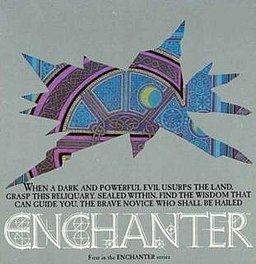6.6 /10 1 Votes6.6
Engine ZIL Initial release date 1983 | 3.3/5 Abandonware DOS Mode(s) Single-player Genre Interactive fiction | |||||||||||||||||||||||||||||||||
 | ||||||||||||||||||||||||||||||||||
Release date(s) Release 10: August 10, 1983Release 15: November 7, 1983Release 16: November 18, 1983Release 24: November 18, 1985Release 29: August 20, 1986 Similar Infocom games, Interactive fiction games | ||||||||||||||||||||||||||||||||||
Enchanter is a 1983 interactive fiction computer game written by Marc Blank and Dave Lebling and published by Infocom. It belongs to the fantasy genre and was the first fantasy game published by Infocom after the Zork trilogy (it was originally intended to be Zork IV). The game had a parser that understood over 700 words, making it the most advanced interactive fiction game of its time. It was Infocom's ninth game.
Contents
Plot
Krill, an incredibly powerful evil warlock, is spreading chaos and destruction. None of the more experienced members of the Circle of Enchanters dare to attempt to stop him. In desperation, the player, a novice Enchanter with only a few weak spells in his spell book, is sent in hopes that Krill will either fail to detect him or dismiss him as harmless. More powerful spells can be found on scrolls hidden in various locations, but as the player becomes more of a threat, Krill will respond accordingly.
This game features an innovative new spell system based partially on Ursula K. Le Guin's Earthsea series and partially Dungeons and Dragons' Vancian spell system, where spells must be prepared through "memorization" before being cast. As in the Earthsea series, each spell is represented by some nonsense "magic word" which is treated as a verb by the game's text parser, so that one can use the FROTZ spell (which causes objects to glow and give off light) by typing >FROTZ BOOK, in exactly the same way as one might type >PICK UP BOOK or >READ BOOK.
There are references scattered throughout Enchanter's documentation and gameplay comparing the use of spells by mages to the use of command line interfaces by programmers, and comparing mages to hackers in general. Many of the spell names, such as FROTZ and GNUSTO, are taken from MIT hacker slang of the time; others are various pop cultural references or anagrams. (For instance, the NITFOL spell allows one to speak with animals, and NITFOL is a truncated reversal of "LOFTING", after the author of the Doctor Dolittle stories.)
Remake
In 1993, about ten years after the original Enchanter, a remake of the game was developed and published by Japanese software development company SystemSoft for the NEC PC-9801, entitled Enchanter: Wakaki Madōshi no Shirén (
Reception
Released in September, 1983, Infocom sold about 50,000 copies of Enchanter by the end of 1984, and 75,000 over its lifetime or as part of the Enchanter Trilogy. Computer Gaming World's Scorpia praised the game as "typically excellent" and up to the standards expected of Infocom games. Ahoy! wrote that "Enchanter is filled with the usual Infocom doses of wit, red herrings ... twists, turns, and surprises". It stated that while beginners would enjoy it experienced text adventure gamers "may be disappointed. There didn't seem to be a whole lot to do. I solved the game in record time, for me; it left me wanting more ... The very moniker "Infocom" may be raising my expectations too high". John J. Anderson wrote in Creative Computing "With Enchanter, they have scored again ... Enchanter is full of the delightful little touches we have come to expect from Infocom." Compute! stated that Enchanter had "nothing strikingly original about it, but you'll appreciate its high level of challenge and meticulously maintained continuity". It stated that "some of the humor lacks, well, subtlety", citing the name Dimwit Flathead as example, and that "the narrative won't win any literary awards, either".The magazine concluded that it "is an excellent game for adventure freaks".
In 1998, AllGame's Lisa Karen Savignano gave the Apple II version three-and-a-half stars out of five, saying, "If you like really hard adventure games with knotty puzzles to unravel, you will like Enchanter. And even if you have trouble, there are always clues to help you."
Historian Jimmy Maher wrote in 2013 that Enchanter "is in my personal top five or so of Infocom games", describing it as "a brilliant collection of interlocking puzzles that are challenging but solvable" and praising the "absolutely brilliant" magic system. Comparing its sales to the more popular Zork series, he added that "it's probably safe to say that Infocom's decision to make Enchanter its own thing had commercial consequences".
